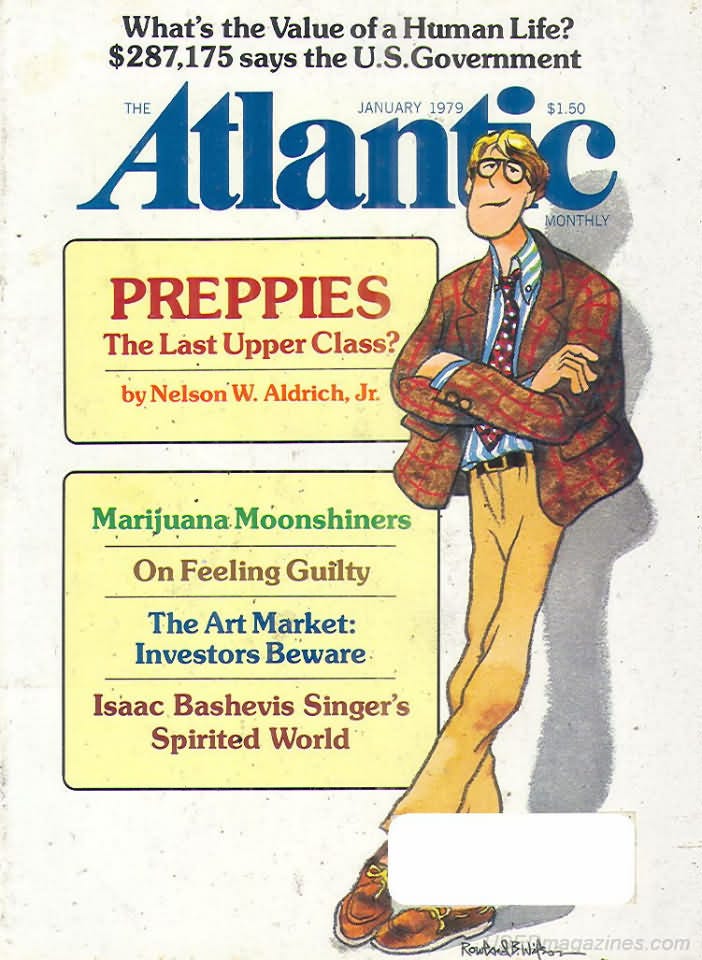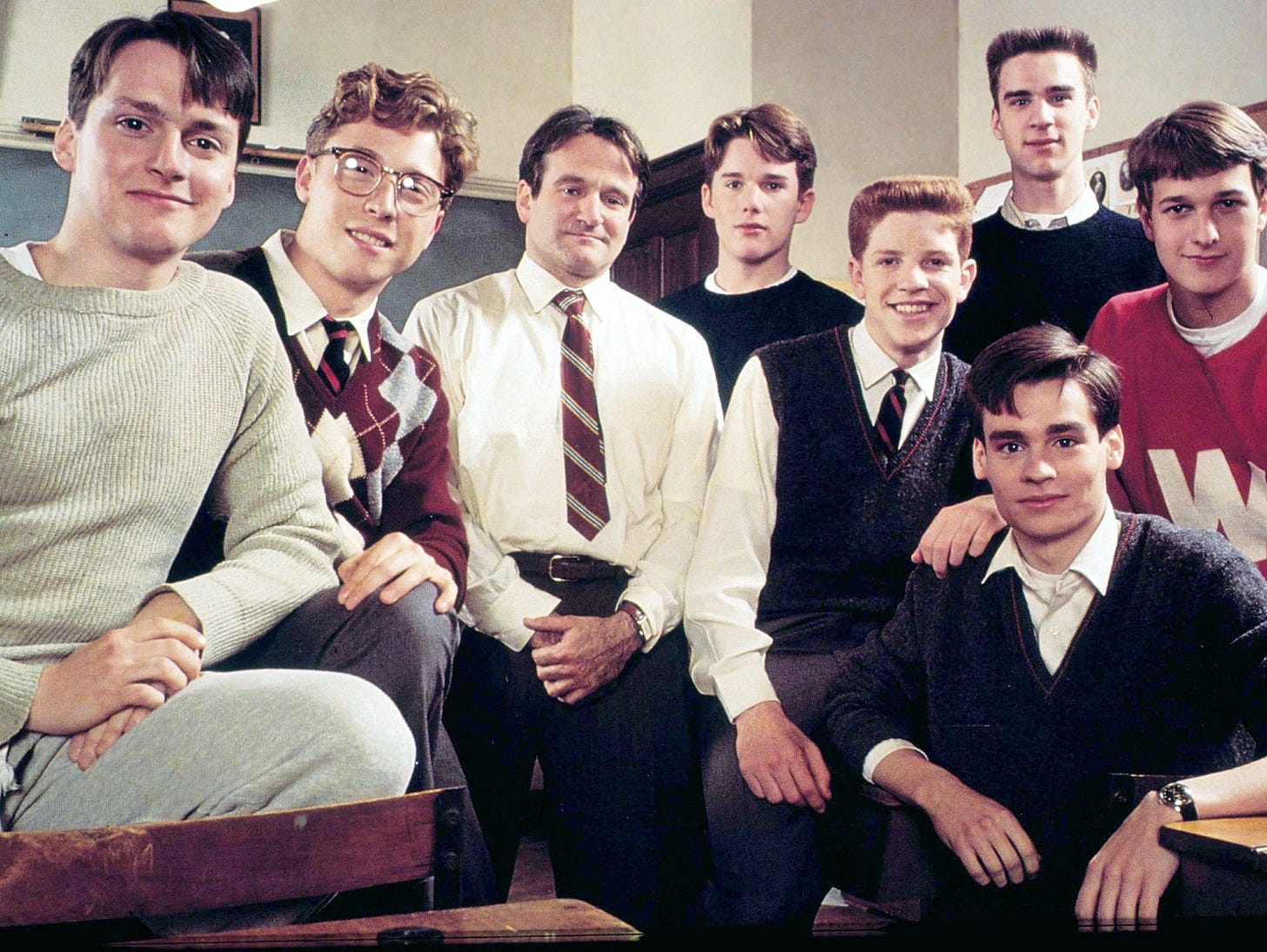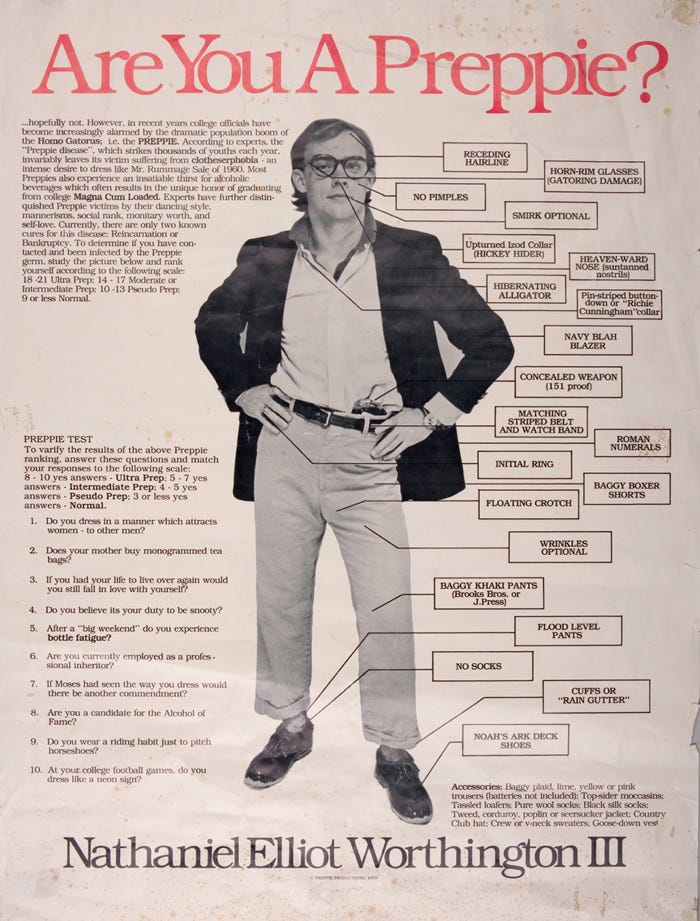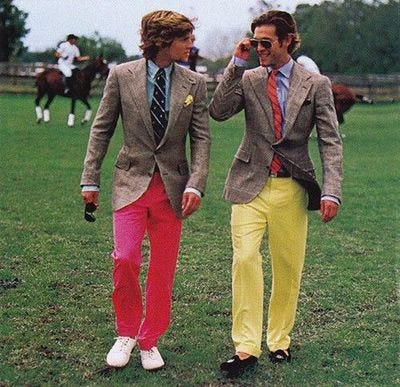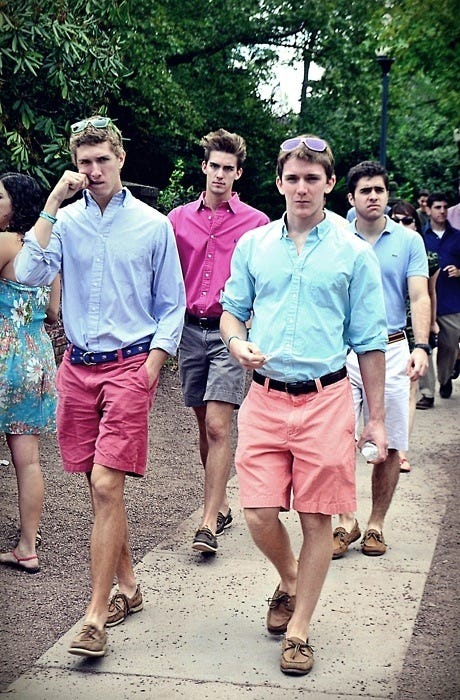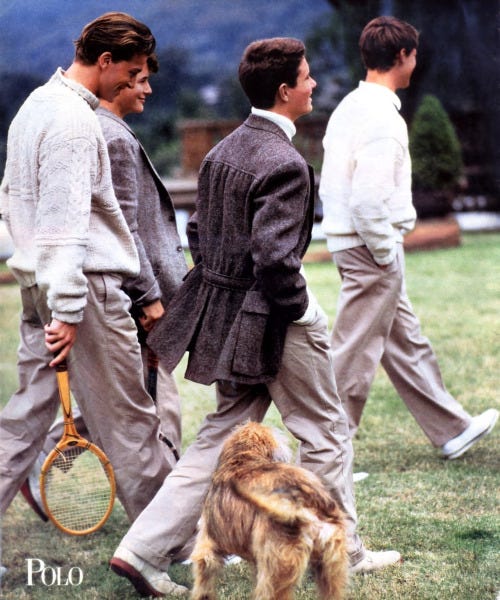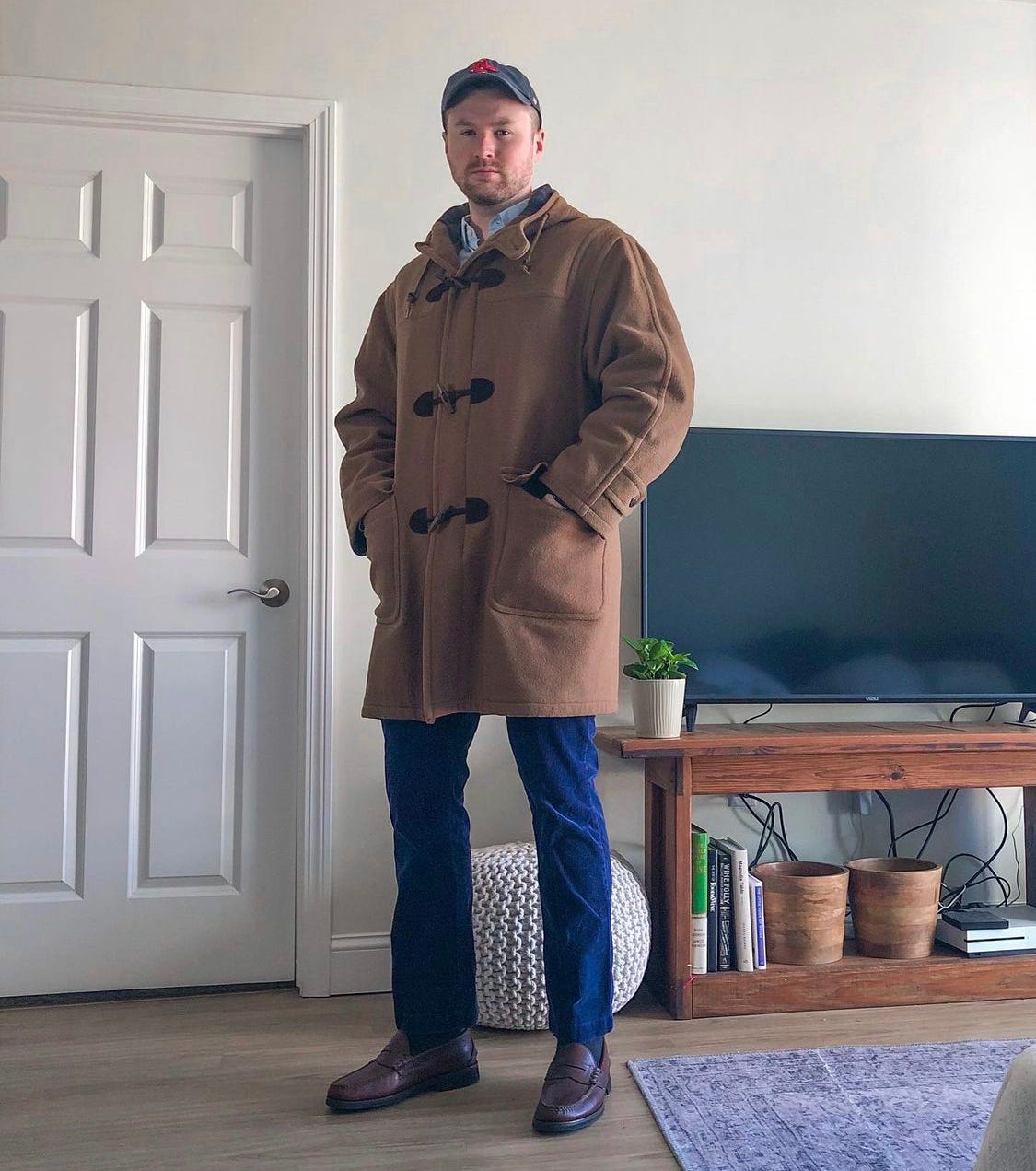If you enjoyed this post, please consider subscribing. Although my articles are free, there is an option to support my work for $7/month or $70 for an entire year if you feel so inclined.
If you’re tight on money but still considering a contribution, please reach out and we can arrange a discounted rate.
Preppy: A word that disgusts some and enthralls others.
The act of dressing preppy seems to be increasingly controversial these days — the whole getup elicits a sense of exclusiveness that sours the expressions of many who are hoping to create a perfectly inclusive world.
The name itself conjures up visions of trust funds, lacrosse, and yacht rock (this is a pro-Steely Dan publication), mixed with the pastel-laden imagery of a Vineyard Vines catalog.
While preppy style (referred to as “prep“ from here on out) certainly has its roots in elite private preparatory schools, the style as we know it today has more or less transcended them. Today, you’re more likely to hear the word in reference to dressing well (at this point wearing a collared shirt meets this criteria), than as a reference to a unique American subculture — and while you’ll still find prep school kids wearing Brooks Brothers, L.L. Bean, and J. Crew, you’re just as likely to see them sporting athleisure or streetwear fits.
Alas, “prep” the style and “prep” the institution are two different things — something that will be made much clearer through the course of this article.
Q: Vineyard Vines: Prep or cringe?
A: Cringe
Origins
As mentioned mere moments ago, the origins of prep come from prep schools. Specifically, the elite prep schools of the northeastern United States. Shortly after the Industrial Revolution in the 19th Century, old money WASPs found themselves confronted with a rising class of new wealth. To maintain their positions as America’s aristocracy, these old money WASPs established many elite private schooling institutions that were isolated from the new money as well as the lower classes. These private preparatory schools acted as pipelines directly to the best colleges in the country at the time (e.g., the Ivy League), allowing their progeny an easy head-start over those that did not have access [1].
From The Dead Poets Society (1989) - Moppy hair, wool sweaters, and repp stripes. Good stuff.
Prep was deliberately difficult to copy at first. Items such as polo shirts and boat shoes - sportswear that served a very specific purpose - were pretty much only available to those who partook in these exclusive leisure activities. The preps adopted the functional garments from their recreational hobbies into their wardrobes and allowed it to blend with the more traditional components.
Nevertheless, the styles of America’s old elite slowly began to proliferate (much to their chagrin), as people began to emulate their look — the lower- and middle-classes copying the airs of the aristocracy has been happening since time immemorial, so this was bound to happen at some level.
I should take a moment here to clarify that money was generally not an object to preppies (even if it was). What WASPs (preppies) were after was the protection of their identity as the aristocracy.
It’s rather difficult to conceive of an American aristocracy, as our class system now is almost entirely predicated on one’s net worth — consider here the recent hatred leveraged at the 1% (people who earn ~$500,000+ per year). In other words, the WASPs wanted it to mean something when one would say that they were an Astor, a Cabot, or a Wharton.
Unfortunately for them, they failed!
Now I’m not saying that there aren’t havens all across the US that these old money families have access to, but for the most part you can buy your way into any exclusive establishment at this point.
The great legacy of the preps is their general disposition and the timeless style in which they dressed.
Well? Are you?
Styling
The Official Preppy Handbook states that a prep’s wardrobe emphasizes a few things:
Attention to detail - your oxfords absolutely must have a 3-inch unlined collar and a locker loop.
Clothing brands - the ‘right‘ brands are the only acceptable ones
A certain level of androgyny - it used to be common practice for girls to wear their older brothers’ hand-me-downs!
From The Official Preppy Handbook (1980)
This second point I personally find to be in flux a bit — the traditional brands that make up a prep’s wardrobe were deliberately chosen because of their superior quality. Unfortunately now we are witnessing many of the preppy mainstays get gutted both from a financial and quality standpoint by private equity firms (hello Brooks Brothers and J. Crew).
Nevertheless branding is important, but not in an overt way. For example, Louis Vuitton, despite the price tag and associations with the rich, is tacky. Here we want clothes with little to no branding that still manage to stand out to those who know (e.g., Brunello Cuccinelli, a luxury brand known for its knitwear, does a good job at this). Prep in a sense is the ultimate IYKYK in the world of styling.
Otherwise, prep as a style has an emphasis on fabric, patterns & texture — think of corduroy, seersucker, madras, silks, tweeds, critter shirts/pants/ties, university stripes, repp stripes, argyles, and tartans. Pastel colors and earth tones should make up the majority of the wardrobe. Of course the go-to-hell (GTH) option is one that many preps hold dear — this concept has recently been appropriated for the hellscape of modernity under the name powerclashing.
For fit, slouchy is preferred, and skinny-fit abhorred. As always, there is usually some sort of middle-ground that can be found between JNCOs and nut-huggers. The fit offers the most room for experimentation, so find something that works for your body — you don’t want it to look like your clothes are wearing you.
I also recommend investing in a sewing tape measure so that you know your dimensions a bit better — this is especially important if you plan on shopping second-hand, as clothes tend to shrink or stretch over time.
GTH styling - neon pants with traditional tops
Southern Prep
Southern prep is quite similar to its northern counterpart, but different in a few key ways. I could be wrong on this, but from my understanding southern prep is an exaggerated derivation of Northern prep, that has since taken on its own life.
First and foremost, southern prep is defined by its use of color. Bright pastels and bold patterns (e.g., Lilly Pulitzer) can be much more emphasized down South, but that’s not necessarily the case at all times.
Selective use of fabric is much more emphasized in the South as well. Southern heat is an entirely different beast from anything that you can experience above the Mason-Dixon line. Madras and seersucker, two very breezy cotton weaves, are much more common there.
Field sports (i.e., shooting, fishing, hunting) are way more popular than they are up North, and that is appropriately reflected in the Southern gentleman’s wardrobe. Mallard motifs, gun dog apparel, and shooting patches fit right in.
Kevin’s Catalog (no relation!) is a sterling example of tasteful southern prep.
The OG “my dad’s a lawyer“ fit
Basic Wardrobe
The lists of brands in this section are non-exhaustive. There are many great options and it’s likely that I forgot a few here and there.
Tops
Button Downs - The mainstay in any prep’s wardrobe. Oxfords are most prominent, but sport shirts, tattersall, corduroy, seersucker, and madras are also prevalent.
J. Crew, Land’s End, Brooks Brothers, J. Press, Polo Ralph Lauren, Kamakura, Mercer, Castaway Clothing, Beams+, Drake’s
Rugby shirt - Comfortable and durable. Some layer these with an oxford underneath.
Columbiaknit (different from Columbia!), Polo Ralph Lauren, Rowing Blazers, Withernot
Flannel - Great for Autumn/Winter. If you live in a cold area, chamois cloth shirts are a thicker alternative.
L.L. Bean, Land’s End (I actually prefer their flannels to L.L. Bean), Vermont flannel
Polo - Made for tennis. Deceptively difficult to find one that fits well.
Polo Ralph Lauren, Brooks Brothers, Peter Millar, Lacoste, Sunspel
Sweater - Best to get them a size up for layering purposes. Wool and cotton are good, but acrylics should be avoided.
Cable-knits, fair-isles, Shetlands, argyles
Brooks Brothers, Spier & Mackay, Land’s End, L.L. Bean, Beams+, Jamieson’s of Shetland, Aran sweater market, Andover Shop, O’Connell’s, J. Press (the shaggy dog is an icon)
A note on cable-knits - an authentic Irish fisherman’s sweater is the way to go. If you have strong Anglo-Celtic genes, you may even have a clan-specific cable pattern - here’s mine (they were used to the identify bodies of fishermen gone overboard!).
Shawl cardigan - For cozy fall vibes.
See wool sweater section
Turtleneck - Good for layering (you lose a lot of heat through your neck).
See wool sweater section
The Navy Blazer - For formalities and fraternity pledging. Often paired with khakis.
Brooks Brothers, Andover Shop, O’Connell’s, Spier & Mackay
Tweeds - Harris tweed is best.
Pants
Chinos
Jack Donnelly, Duck Head, Polo Ralph Lauren, Brooks Brothers, J. Crew, Murray’s Toggery Shop (for Nantucket reds)
Corduroys - The wider the wale, the preppier it is.
Polo Ralph Lauren, Beams +, Vineyard Vines, L.L. Bean
Flannels - The wool flannel, not the cotton ones.
variable
Madras - Good for the Summer. Patch madras is eye-catching in a good way.
Polo Ralph Lauren, Castaway Clothing, J. Crew
Jeans - not technically preppy, but can be adapted to the modern interpretation of it pretty readily
APC, Nudie Jeans, Naked & Famous, 3sixteen, Oni, Unbranded, Madewell
A note on jeans - jeans have a very rich subculture and there are many smaller brands that are gatekeeping (a good thing in many scenarios) the quality standards of their garments. Look for selvedge and raw denim if you like it.
Shorts
Chino shorts - Probably want to opt for 5” or 7” inseams
Brand doesn’t really matter all that much. I like Patagonia and Bear Bottom.
Patagonia baggies - Nylon shorts designed for the outdoors. They are excellent and roomy.
Seersucker - Another breezy fabric for the summertime.
Madras - you can do madras shorts, I’m just not sure that you should.
Shoes
Penny loafer - Beefrolls are best.
G.H. Bass (the original weejun), Rancourt, Quoddy, Oak Street Bootmakers, Alden
Horsebits - Also known as deal sleds. Business connotations for the most part, but can be dressed down to a degree.
Gucci (the gold-standard for horsebits), Ferragamo, Oak Street Bootmakers
Tassel Loafers - Originally considered a lawyer’s shoe, but has more casual connotations nowadays.
Brooks Brothers, Alden
Bean boots - An iconic look, but they can smell awful.
Gumshoes - Bean boots but shorter.
Boat shoes - Originally made so that sailors wouldn’t scuff the decks of their boats.
Sperry, Quoddy, Rancourt, Eastland, Sebago
Sneakers - Opt for chunky dad shoes or something low-profile.
Sperry canvas deck shoes, New Balance, Common Projects Achilles
Moc-toe shoes/boots - Good for more rugged uses.
Red Wing, Rancourt, Quoddy, Yuketen
Bucks - Nubuck shoes often paired with a red clay sole. Opt for white or “dirty“ tan bucks.
Brooks Brothers, Eastland, J. Crew,
Outerwear
Topcoats - Usually for wearing over a suit, but they can be dressed down easily.
Brands are variable, just try to get one that’s 100% wool.
Field jacket - Hunting/shooting jackets.
Barbour, Belstaff
Duffle coat - Originally from Belgium. ‘Duffel’ is a thick wool material and was adopted by many of the militaries of Northern/Northwest Europe. Seen on Paddington Bear.
Gloverall, J. Press, Brooks Brothers, L.L. Bean
Harrington - Popularized by Steve McQueen, James Dean, and Frank Sinatra
Baracuta
Quilted jacket
Barbour, J. Crew, Brooks Brothers
Quilted/fleece vests - Part of the Midtown uniform.
Barbour, Patagonia, Arc’teryx
Puffer jacket - Aiming more for the hiking-style puffer here.
Patagonia, L.L. Bean
Accessories
Watches - The male version of jewelry.
Timex, Seiko, Omega, Rolex
Ties - Some people wear them casually, I generally don’t though. Moreso a personal style decision and a good way to add some personal flair to a suit.
Brooks Brothers, Polo Ralph Lauren, Vineyard Vines, J. Press, Hermes
Belts - Needlepoint and surcingle are the preppiest.
Smathers & Branson, Vineyard Vines, J. Press
Gloves - Opt for leather over fleece. Cashmere-lined is a huge plus.
For Your Consideration
Cheap Basics - If you’re in high school/college and have a limited budget, I would recommend checking out Uniqlo. It’s not a ‘preppy’ brand by any stretch of the imagination, but it’s decent quality and cheap. They do lots of collaborations with big-name designers which usually turn out very nicely. J. Crew (on sale only - you can find oxfords for as low as $15 if you’re patient) and J. Crew factory (very low quality as a warning) are also good budget spots to check out.
Vintage - Grailed, eBay, and Poshmark are all great places to find used clothing at good prices. Some things just aren’t made anymore, and many brands are much lower quality than they used to be. I grabbed a vintage L.L. Bean made-in-USA duffle coat (below) from Poshmark last year on the cheap, and it’s one of my favorite purchases.
Domestic production - I personally find it very important to promote manufacturing in the United States, for pretty obvious reasons. It’s good to support our own communities and you usually walk away with superior-quality items.
The Official Preppy Handbook - Written with the intention of a derisive lampooning of WASPs. Ended up becoming a best seller and cult-classic instead. Lots of tongue-in-cheek humor.
True Prep - I read it so you don’t have to. Same author as tOPH, but the humor is forced and the resentment palpable.
Take Ivy - A preppy mainstay and the progenitor of Ivy Style (essentially prep at the collegiate level). I plan on doing another guide specifically for Ivy style, so hang tight.
Preppies: The Last Upper Class? - A great synopsis of prep from 1979. I pulled much of the info in this newsletter from Aldrich’s article.
My first-ever fit pic. L.L. Bean duffle coat, Jack Spade (now extinct) OCBD, Vineyard Vines corduroys, Alden penny loafers. Simple really… 🥂
Cover photo: Preppies, The Last Upper Class? — Nelson Aldrich Jr. for The Atlantic Monthly (1979)
As always, if you enjoyed this article please like, comment, share, & subscribe. Your interactions are a huge incentive for me to keep making quality content.


